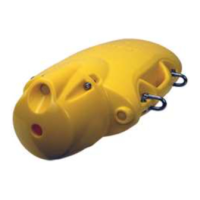FS 70 System Operation
974-24007001/5.0 31
F --- Search for the next Field Delimiter
I --- Ignore a character
N --- Print as ASCII to the next Field Delimiter
D --- Insert a Decimal point
S --- Insert a Space
Example
Suppose you had a device which provided distance travelled through the water using the
NMEA defined VLW sentence:
$--VLW,x.x,N,x.x,N*hh<CR><LF>
where:
$--VLW identifies the start and type of sentence,
x.x is a variable length data field showing the cumulative distance travelled through the
water.
N specifies the distance units to be in nautical miles,
x.x is a variable length data field showing the distance since reset,
N specifies the distance units to be in nautical miles,
*hh is a checksum,
<CR><LF> is a terminating carriage return and line feed pair.
This sentence always starts with the $ character, so we would set the Start Character for this
data to $ (Hex 24 or Binary 00100100).
The data is separated into fields using commas, so we would set the Field Delimiter for this
data to , (Hex 2C or Binary 00101100).
Suppose we wanted to display only the cumulative distance and the distance since reset
from this data string. We could set the Display Format string to FNFSSN. The first F would
ignore everything up to and including the first comma, the first N would display the
cumulative distance field, the next F would skip the next field, the SS would print two
spaces to separate the data, and the final N would display the 'distance since reset' field.

